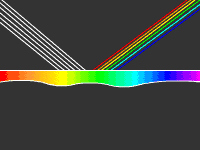

| Rays of light have several fundamental properties. As three laws of light, well known are the laws of straightness, reflection, and refraction. As wave-like behavior of light, there are dispersion, diffraction, and interference. |
  |
A ray of light goes straight in the uniform medium without an obstacle. This is the law of straightness of rays. Due to straightness of rays, light emitted from a point source spreads out in a spherically-symmetric manner (spherical wave), while light emitted from a plane source propagates in a plane manner (plane wave). The latter is so called parallel rays.
|
|---|---|

|
In general a ray of light incident on the smooth plane (surface), such as a mirror, metal, and water, is partially reflected (reflection). The angle between the incident ray and a perpendicular line to the plane is called an angle of incidence, and the angle between the reflected ray and a perpendicular line is called an angle of reflection. The law of reflection tells that the angle of reflection is equal to the angle of incidence.
|

|
A ray of light incident on the boundary surface of two distinct medium, such as air and water, is refracted, when it enters from one medium to another (refraction). The angle between the incident ray and a perpendicular line to the surface is called an angle of incidence, and the angle between the refracted ray and a pependicular line is called an angle of refraction. The law of refraction tells that the angle of refraction is determined by some relations between the refraction index of two media (Snell's law).
|
 |
When a ray of light goes from a medium with small refraction index (e.g., air) to a medium with large refraction index (e.g., water), in some case all of the incident ray are reflected and refracted rays do not appear. This is total reflection.
|
| (1999-2001 Photo by Y. Awano and J. Fukue) | |
 |
The refraction index of light slightly differs
for different wavelengths.
Hence,
when the white light consisting of various light with various wavelengths
enters the refractive media, such as a prism,
the white light is separated into various monochrome rays.
This phenomena is called dispersion of light.
|
|---|---|
 |
Due to its wave-like nature of light,
the trajectory of light is slightly bent
at a cutting edge of a body.
This phenomena is called diffraction of light.
The magnitude of diffraction depends on its wavelengths.
|
 |
Light rays reflected at a upper surface and a lower one
of a thin film (membrane) strengthen or weaken each other,
and
light rays pass through two close slits do.
This phenomena is called interference of light.
|
 Go to Submenu
Go to Submenu Go to Menu
Go to Menu
自然科学書出版 裳華房 SHOKABO Co., Ltd.